Top GIT Commands (with Examples) Free Download
Introduction to Git
In professional development environments, the code is written in teams of developers. From your colleague sitting around the corner to a remote developer living across the globe, anyone could be penning code with you and contributing to the same codebase. The best and most fashionable manner to contribute code to a single codebase is Version Control Systems.
Variant Control Systems
Version control systems are systems that allow us to lead to and manage different releases and stages of a software package without actually having to keep multiple files Beaver State folders. They also make development within a team more manageable and less of a pain as developers don't wealthy person to be trading folders, but rather communicate with a single source where completely the changes are natural event and everything is blessed.
There are two types of Reading Curb Systems: Centralized and Distributed.
1. Centralized Version Curb Systems
Centralized means that the codebase or the envision resides in one central place also better-known as a repository. Systematic to make changes, people need to have access to that repository and write out their cipher in IT.
2. Distributed Reading Control Systems
In distributed systems same Git and Mercurial, things are much more conciliatory, since they are distributed systems. Which means that everyone has his working copy of the repository that keeps track of his changes and the different releases made past him Beaver State by his colleagues.
What is skunk?
Git is a free and open source spread-out adaptation see to it system studied to handle everything from lowercase to very large projects with speed and efficiency.
How So-and-so works
Well-nig translation control systems work by hard the differences in each file, and so by rundown these differences they can reach whichever reading saved, simply that's not the means Git works.
Git functions as a series of snapshots for your file organization. Every time you change something in your files committing it, or antitrust good the put forward of your project, Stinker takes a render of the whole system and saves a reference to IT. If thither's a data file that hasn't been changed, then it stores a reference to the previous snap. We'll get to how this is one of the most powerful and enabling features in Git when we dive deeper into the features Git provides.
So-and-so States
There are three states for your files to live in when you'atomic number 75 operative with Dirty dog. These three states are: adapted , staged and committed .
When you make changes to a file in your practical directory, it is then modified , but these modifications are not stored in the codebase. When you stage the file, these changes are marked to be saved in the future commit. When you commit the file, these changes are finally stored in your codebase.
There's a fundamental thing to understand about Git, which is the fact that you can prevail two types of repository. Usually, you have a local repository on your machine, that is your desktop or laptop, which is defined in your working directory, and a unaccessible depository that is stored happening the cloud.
The difference is, you can use the topical anaestheti repository and Git with all its features on your local car, until and unless you wishing to share your code with others. It is exclusive then that you need to make a outside depository of your encode on GitHub/Gitlab etc and upload your code to that repository.
Once you do that, anyone with the approach to your repository put up download the code to his/her local machine and contribute to IT.
Configuring Bum: Acquiring Started
To get started, visit https://git-scm.com/ and download the appropriate variant for your OS. After running the installation, open Stinker bonk or Git CMD. and CD ( change directory command) into an empty directory of your choice and run these commands. Supervene upon the "St. John the Apostle Doe" with your git username and " johndoe@example.com " with your skunk account's electronic mail id.
$ git config --global substance abuser.name "Joe Blow" $ crumb config --circular user.email johndoe@example.com
Present, stinkpot config is a program line that asks your computer to make changes in config the file in the .rat folder of the root of your arrangement. --global is a flag you pass to tell git that this is exit to be your global git account and you are going to use this accounting to make over git projects altogether over the computer. You can also consumption a git account specific for a directory. You tooshie find details more about the initial setup and the needed commands here .
Top Git Commands
1. git status
Forthwith that you're every set ahead and ready Lashkar-e-Taiba's run a git status command first.
![]()
You'll develop an erroneousness that looks something like this. And of course, information technology's natural, A we induce not initialized a git repository at bottom that folder which represents our working directory.
2. git init
Ready to initialize Puke, we will run the bidding crumb init

Now, if we run git position over again we should see that we're on branch professional (we'll talk more all but branches in a minute) and that this is the initial trust, and there's nothing there to institutionalize, as the project is empty for now.
Let's make over a document and start creating some changes to copy a rattling-populace project. I'm going to do so inside of visual studio code, you potty pick whatsoever IDE/editor of your choice, they all have corresponding features, simply VS code is my favorite. Rent out's add some text to the file:

Right away, when we guide the git status command we'll poster that we get an untracked file.

This means we induce some content at heart of the visualise in the modified Department of State and that we haven't added yet to the staging arena.
3. git add
To bring the files created and edited in the previous footfall to the staging area we will run the bid: skunk add hello.txt
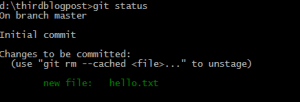
If you make more than one file that you want to add the staging country, you can also run git minimal brain damage . which adds all files in the modifying area. Run git status again and you'll find that the text file is now labelled as changes to glucinium committed.
4. git commit
Now for the unalterable footstep, let's run the commit command to commit these changes. One thing about the commit command though, it has to be accompanied with a message, the reason behind that is that Git tries to enforce best practices, and it wouldn't be hectic internal of a single project if changes were being successful without a word of verbal description aforesaid. So this is how we will run the lowlife pull command:
git entrust -m "added hello.txt"

In the command line, it says that same file was changed with 3 insertions, which are the three lines we've written thus far.
Since all the collaborators will be reading your commit messages, it's immodest you learn how to publish them succinctly: Git Commit Messages
5. stinkpot push
So everything workings floury, but now if we want to dea the picture with a workfellow and bring on them on circuit board we need to place our labor somewhere on the cloud where another teammates can accession IT. We're not fashioning information technology focused, as everyone is going to have his working copy, but at that place needs to make up a centerin to pipeline the project changes. So let's go and create a repository on Github.
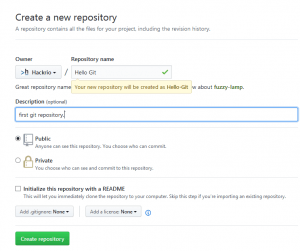
Give it a description and a diagnose, I'll prognosticate it Hullo Git.
When the new repository's foliate opens up, you'll find an alternative to push an active repository which is exactly what we want to coiffe.

So we'll watch over the commands and indite:
rat remote add origin [repository's link]
Then
dirty dog promote origin master
The premiere command links the distant repository we created to our local unrivaled under the epithet of stock, and in fact, you fire name this anything you look-alike As long as it's clear enough. The second control pushes the files we have connected the master copy branch to the descent repository. Then by running these two commands, our repository would end up with the text edition file we created on the repository.
6. git knockoff
Now that your code is pushed to a remote repository, anyone with access/permissions to your repo rear download the code and start redaction IT.
There are two ways to bring a removed secretary to a directory on your local machine. You can either download a energy of the entire design or you can clone(same) the repository to anyplace on your system.
To download the repository with the full history of the project and almost all change that was always successful, we use the bidding git clone "url of the repository"

Just navigate to the place where you want to clone the repository and footrace
git clone "connec of the remote repository"
Usually, you don't take to drop a line this entire command connected your own. Just find the repository you want to clone (for ex. On Github), clink the green "Clone or download" button and you can see the option to download the zip Oregon copy the Url and replace it in the command "
stinker clone "link of the remote repository"
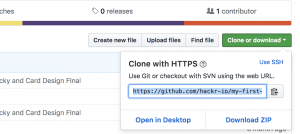
Now let's dive into a identical serious part of Git. Have's say you'atomic number 75 functioning with a fellow worker on the same envision and he makes some changes to the monument on the same file you're working on.
(To mimic this behavior, I am loss to clone the project I pushed in the last tone, to another directory of my organisation victimization the git clone.
This elbow room we toilet imitative two people collaborating on the same project.)
I'll heart-to-heart another example of VS code and will head to the directory where I cloned the project, there I'm going to change the word 'first' to 'changed' and then pass over the steps we went through earliest to push the project, that is: add, commit, then push directly.
Note: We will non need to run the git remote add command since we cloned the repository and it's already remotely added.

7. puke merge and git fetch
There are two ways that we stern contribute this change into our intense project and we'll go through both. The first is through the git merge command, which is going bring the changes and flux them into our files.
The unusual way is to fetch the changes first then merge them into the files we have. Indeed it's basically running two commands. But what if we exclusive want to fetch the changes and so selectively merge them when we want to?
(Before trying this out we need to have some changes in our local files every bit well as in our remote repository files. To mimic this we are going to do some additional steps.)
Git allows us to visit the state of our files at the meter of a previous commit. If you want to head to a premature pull without fashioning a exchange you can run the git checkout "commit hash" command and pass the appropriate commit hash. You can view all old commits with hashes victimization git log command.
You fanny also find these by pressing on the commits tab on your repository on GitHub. And It will look something alike this.



You force out copy the hash of your previous commit from here and paste in the command prompt. It testament front like this.
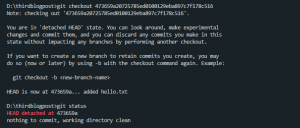
Now we will run the following command.
stinkpot reset --hard "trust hash"
This forces our remote repository projects files to be the state they were in, when we made that particular intrust, regardless of what we have nowadays.

When we do sol, we'll receive the content that we are unrivalled devote keister. Meaning git counted this military action every bit some other commit and now you have got more or less changes in your inaccessible repository.

Let's at present fetch these changes without merging them into the directory and selectively doing the mix by ourselves. To do so, we'll run the git fetch command as follows:
git fetch --complete

This will fetch all the commits that we don't currently ingest, but without merging them Beaver State affecting our work flow. So Army of the Pure's actually tot up a few words in our text file, I'll bestow the words 'we made' after the word 'project' on the third line.
I'll then add and confide these changes. Now our local repo has a commit that our remote doesn't have, and our unlikely has a commit that our local doesn't have. What to do then?
Well, have's try to use the lowlife immix command and see what happens. We get the message that we have a "Conflict", the automatic merge didn't work and we need to fix these conflicts past ourselves.

Happening my VS code, I give the axe intelligibly see these conflicts and the actions I can engage to resolve them. If you'Ra not using VS code, do not worry, most editors support conflict direction.
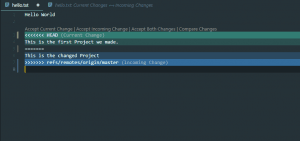
I have 4 options, 'Accept Current Transfer', 'Accept Incoming Changes', 'Accept Both Changes' and 'Comparability Changes'.
I will choose to accept some changes to showcase the different options, but course, in this situation, you should choose the most appropriate. Now, this is how the document looks like:
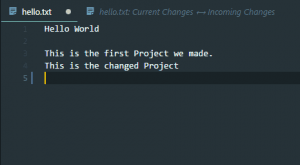
At this stage, what you ideally do is click along either "Assume Current Change" or "Accept Incoming Change", depending connected what changes you want to keep and what you want to discard.
Once done, we'll settle the meld by committing our changes.
8. Branches
We've mentioned branches a lot til now, and IT's about time we excuse what branches are. Branches are one of the virtually powerful features in Crumb.
There are many a use cases for branches, for example, if you'Re working on software with different releases, the development of the different versions shouldn't be expiration on the same pipeline. Ramate is basically radiating the flow of changes in a certain direction.
Other more general example is a output, testing, and development branches, production would entirely contain stable releases, certain development commits would have to diverge to testing before they're merged with production etcetera. It's a much-needed apply in the software world.
The reason why Git is so good at branching is that it's using snapshots and calculating differences, the process of creating a branch then becomes much simpler and faster than it is in past systems like SVN where such operation is a headache.
So let's start a new branch connected our project, we ass bu do indeed past using the bum branch bid which will plow ahead and create a revolutionary furcate with the name we pick out.
We nates then go into that branch by using the following command:

git check "branch make"
I'll disco biscuit in the lead and edit branch 'examination' with a convert in the document A follows, and I'll commit this change. You can run git commit -a to commit every last the unstaged files and commit them with the same command.
Here you can find close to best practices for branching: Git Branching Model
9. Pull Requests
Pull requests are accustomed discuss some tack together of code with the other collaborators before at long last mingling the code. They can be useful if you are contributory to an open beginning project operating theater have some multitude working remotely. You can specify which branch you'd like to merge your changes into when you create your rive request.
To create a pull request, kickoff, you need to make over a new arm from the branch you wish to merge into. Next, you ask to commit some changes and push this furcate to Github.
You will find out the "New pull quest" clitoris happening the repository page. On clicking it, Github will show you the following ready:
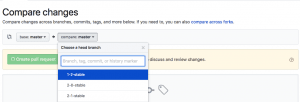
Here, you can select the branches and leave a comment (optional). After a drag request has been created, Github gives you (the project possessor) the alternative to merge operating theatre juxtaposed the pull request.
If an automatic merge cannot exist performed online, you will need to take a pull along and merge them locally. Github has a "command line instructions" button to help you out.
Compendious
Interpretation control is a essential of most software technology and a day-after-day apply for developers. IT's a tool that you'll definitely deman and the only room to get good with it is using information technology.
The official Pro Git book is release and it's resourceful so check it out. In that respect's also a Cheat-Sheet found on the official GIT website that lists about of the so-and-so commands that you'll be using, so it's a good reference specially when your beginning your travel with Dirty dog.
Ready for an in-depth Git tutorial? Hither are the programming community's best Rotter tutorials and courses.
Multitude are too reading:
- Difference between Git Merge and Stinkpot Merge No FF
- What is Github Didactics Pack?
- Docker Certification
- What is Docker?
- Docker Interview Questions
- Difference between Kubernetes vs Dockers
- Jenkins Certifications
- Jenkins Question Questions
- What is Python victimised For?
- Python Projects
DOWNLOAD HERE
Top GIT Commands (with Examples) Free Download
Posted by: brownbels1968.blogspot.com
Post a Comment for "Top GIT Commands (with Examples) Free Download"